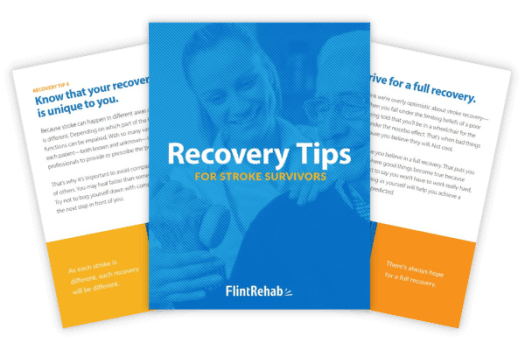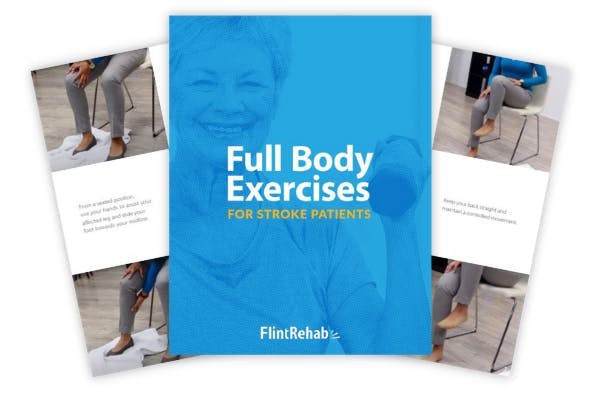No products in the cart.
No products in the cart.
No products in the cart.
No products in the cart.
Home » Neurological Recovery Blog » Stroke » Understanding Your Prognosis After Stroke: Factors That Affect Recovery
Last updated on July 19, 2022

Every stroke prognosis is different because every stroke is different. While doctors and therapists cannot provide an exact prognosis, there are some statistics, patterns, and timelines that can provide a general idea of what to expect.
If you or a loved one have recently experienced a stroke, talk to your medical team about your prognosis. While they can’t tell you the exact outcome, they can provide helpful information such as the area of the brain impacted by stroke, the size of the stroke, and other contributing factors.
This article will help you get a general idea of how the prognosis after stroke is determined and what you can do to maximize your chances of recovery.
A stroke occurs when the supply of blood in the brain becomes compromised, leading to the death of brain cells in the affected area. The brain controls the entire body, right down to your ability to breathe. Therefore if a stroke is severe or left untreated, it can be fatal.
Fortunately, stroke survival rates are the best they have ever been. Advances in how a stroke is diagnosed and treated, as well as the rise of preventative medicine, have reduced mortality rates in recent years.
Some of the leading causes of stroke include hypertension, high cholesterol, diabetes, and smoking, which all damage and/or thicken the walls of the arteries. This increases the likelihood of a cerebral blood vessel getting clogged or rupturing, causing a stroke.
Stroke was the 4th leading cause of death in the US 2010, while in 2020, it moved down to the 5th leading cause of death. Researchers credit improved management of stroke risk factors, such as hypertension control and smoking cessation programs, to the reduction of mortality rates for stroke.
Furthermore, the timeliness of initial stroke treatment has improved too. When stroke patients receive treatment within the first 3 hours, they often have less disability 3 months after a stroke than those who received delayed care, according to the CDC.
Rapid treatment means that blood flow is restored in the brain faster, which helps limit cell death and, as a result, helps minimize the risk of severe disability and death.
While timeliness of stroke treatment predicts a more positive prognosis after stroke, there are a couple other tools that can help provide insight.
Again, it’s important to keep in mind that no one can predict your prognosis after stroke with 100% accuracy. These tools simply help provide more information.
After a stroke is treated, the severity of the stroke is often assessed using the National Institutes of Health Stroke Scale. This scale is used to score survivors in specific areas that are commonly affected by stroke such as cognitive, speech, and motor function.
Severe secondary effects, such as inability to move various parts of the body (post-stroke paralysis), result in higher scores. Survivors who score 16 or higher are considered to be massive stroke survivors. Those who score 15 or lower on the NIHSS are considered to have sustained mild or moderate strokes. Generally, the prognosis after stroke is more optimistic for milder strokes.
However, one study showed that the NIHSS inaccurately predicts outcomes for upper extremities; stating that even if a survivor improves in that area, it would not be reflected in their NIHSS score, and thus the person would not be “measurably” improving even if they are.
This is a great example of why the prognosis after stroke is impossible to predict with 100% accuracy. Instead, all information should be used to get a general idea of where an individual stands, and recovery should be pursued rigorously to maximize the chances of positive recovery outcomes.
Another tool that can provide insight into your stroke prognosis is the Brunnstrom stages of stroke recovery. It provides a framework of 7 stages that survivors can progress through, with stage 7 being a full recovery.
On one hand, it can seem like the stroke prognosis would be less favorable for someone that is “only” in stage 2 of the Brunnstrom framework, where spasticity (stiff, tight muscles after stroke) appears. However, the appearance of spasticity can actually be viewed as a sign of recovery after stroke, since it means the person has progressed through stage 1.
In this way, you can use the Brunnstrom framework to get a rough idea of your stroke prognosis, because the ability to move from one stage to another is a strong indication of recoverability. Talk to your therapist to see which stage of recovery you are in and develop an action plan to help reach the next stage.
Stroke recovery often begins within the first 24-48 hours after stroke.
As the brain is rapidly trying to heal itself after injury, it enters a heightened state of neuroplasticity (the brain’s ability to create and strengthen new neural pathways) where recovery happens more quickly. Rehabilitation specialists should act swiftly in the hospital to take advantage of this state because neuroplasticity is the key to stroke recovery.
Generally, the fastest recovery occurs within the first 3 months after stroke while the brain is in this heightened state of plasticity. Stroke rehabilitation has a greater impact during this time and survivors are encouraged to make the most of inpatient and outpatient therapy.
Once the rate of recovery slows down, survivors tend to hit a plateau. It’s important to know that a plateau does not signify the end of the road — in fact, it’s a sign that rehabilitation methods should be switched up (variety) and rigorously pursued (consistency) in order to keep the brain stimulated and recovery going.
Some studies have shown that the level of recovery for survivors at the 5 year mark tend to be the same as the 2 month mark. While this may validate the stroke recovery plateau, researchers state that lack of rehabilitation after inpatient rehabilitation is the reason for stagnation.
This reasoning is further confirmed by a different article that looked at over 300 studies focused on treatment of chronic stroke. Results indicated that even rehabilitation starting at 6 months post-stroke or later yielded “significant positive benefit” in terms of stroke recovery.
Therefore, overfocusing on your stroke prognosis can often be short-sighted. It does not take into account your work ethic or consistency with your home exercise program, which is the essence of continued recovery after stroke.
Survivors that pursue rehabilitation on a daily basis at home can often exceed the expectations of their stroke recovery prognosis.
The prognosis after stroke is impossible to predict with 100% accuracy. However, there are helpful tools that can provide insight into where you stand and help you envision what continued recovery may look like.
For instance, while massive stroke survivors tend to have less favorable prognoses, they may progress through the early Brunnstrom stages of stroke recovery, which is a strong indication of recoverability.
Ultimately, the prognosis after stroke only looks at a limited number of factors, and it does not take your own work ethic and motivation into account. A large part of recovery happens after discharge from inpatient rehabilitation, where your adherence to a home exercise program will determine whether or not you continue to recover.
No matter what your initial stroke prognosis says, you should always push for a higher recovery. Even if the outcome does not seem favorable, you can often beat the odds by consistently pursuing rehabilitation.

Get our free stroke recovery ebook by signing up below! It contains 15 tips every stroke survivor and caregiver must know. You’ll also receive our weekly Monday newsletter that contains 5 articles on stroke recovery. We will never sell your email address, and we never spam. That we promise.


Do you have these 25 pages of rehab exercises?
Get a free copy of our ebook Full Body Exercises for Stroke Patients. Click here to get instant access.
“My name is Monica Davis but the person who is using the FitMi is my husband, Jerry. I first came across FitMi on Facebook. I pondered it for nearly a year. In that time, he had PT, OT and Speech therapy, as well as vision therapy.
I got a little more serious about ordering the FitMi when that all ended 7 months after his stroke. I wish I hadn’t waited to order it. He enjoys it and it is quite a workout!
He loves it when he levels up and gets WOO HOOs! It is a wonderful product! His stroke has affected his left side. Quick medical attention, therapy and FitMi have helped him tremendously!”
FitMi is like your own personal therapist encouraging you to accomplish the high repetition of exercise needed to improve.
When you beat your high score or unlock a new exercise, FitMi provides a little “woo hoo!” as auditory feedback. It’s oddly satisfying and helps motivate you to keep up the great work.
In Jerry’s photo below, you can see him with the FitMi pucks below his feet for one of the leg exercises:
Many therapists recommend using FitMi at home between outpatient therapy visits and they are amazed by how much faster patients improve when using it.
It’s no surprise why over 14,000 OTs voted for FitMi as “Best of Show” at the annual AOTA conference; and why the #1 rehabilitation hospital in America, Shirley Ryan Ability Lab, uses FitMi with their patients.
This award-winning home therapy device is the perfect way to continue recovery from home. Read more stories and reviews by clicking the button below:
Grab a free rehab exercise ebook!
Sign up to receive a free PDF ebook with recovery exercises for stroke, traumatic brain injury, or spinal cord injury below: